| Listing 1 - 10 of 19 | << page >> |
Sort by
|
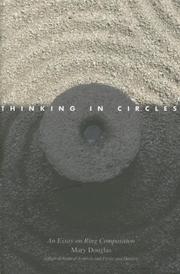
ISBN: 9780300117622 0300117620 9786611734794 1281734799 0300134959 9780300134957 9781281734792 6611734791 Year: 2007 Publisher: New Haven Yale university press
Abstract | Keywords | Export | Availability | Bookmark
 Loading...
Loading...Choose an application
- Reference Manager
- EndNote
- RefWorks (Direct export to RefWorks)
De nombreux textes antiques célèbres sont mal compris et beaucoup d'autres ont été complètement rejetés, tout cela parce que le style littéraire dans lequel ils ont été écrits n'est pas familier aujourd'hui. C'est ce que soutient Mary Douglas dans cette étude controversée sur la composition en anneau, une technique qui place le sens d'un texte au milieu, encadré par un début et une fin parallèles. Selon Mary Douglas, lire une composition en anneau selon la méthode linéaire moderne revient à l'interpréter de manière erronée, et les chercheurs d'aujourd'hui doivent réévaluer d'importants textes antiques provenant du monde entier. Présente dans la Bible et dans des écrits aussi éloignés que l'Égypte, la Chine, l'Indonésie, la Grèce et la Russie, la composition en anneaux est trop répandue pour provenir d'une source unique. Est-elle peut-être liée au fonctionnement du cerveau ? Quelle est sa fonction dans les contextes sociaux ? L'auteur examine la composition des anneaux, ses principes et ses fonctions, d'un point de vue interculturel. Elle se concentre sur la composition des anneaux dans l'Iliade d'Homère, le livre des Nombres de la Bible et, pour un exemple moderne stimulant, le Tristram Shandy de Laurence Sterne, développant un argument persuasif en faveur de la reconstruction des livres célèbres et de la relecture de ceux qui ont été négligés. (Traduction DeepL)
82-3 --- Proza. Fictie. Narratologie --- Narration (Rhetoric) --- Homer. --- Sterne, Laurence, --- Bible. --- Criticism, interpretation, etc. --- 82-3 Proza. Fictie. Narratologie --- Narration (Rhetoric). --- Narrative (Rhetoric) --- Narrative writing --- Rhetoric --- Discourse analysis, Narrative --- Narratees (Rhetoric) --- Aʻdād (Book of the Old Testament) --- Ba-midbar (Book of the Old Testament) --- Bamidbar (Book of the Old Testament) --- Bamidbor (Book of the Old Testament) --- Be-midbar (Book of the Old Testament) --- Bemidbar (Book of the Old Testament) --- Kitāb-i Bi-mīdbār (Book of the Old Testament) --- Minsugi (Book of the Old Testament) --- Numbers (Book of the Old Testament) --- Numeri (Book of the Old Testament) --- Homer --- 82-3 Fiction. Prose narrative --- Fiction. Prose narrative --- Homer - Iliad --- Sterne, Laurence, - 1713-1768. - Life and opinions of Tristram Shandy, gentleman
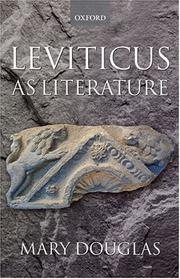
ISBN: 0199244197 0191518387 1282052934 9786612052934 019815092X 0191600547 9780191518386 9780199244195 9780191600548 9780198150923 Year: 2000 Publisher: Oxford Oxford University Press
Abstract | Keywords | Export | Availability | Bookmark
 Loading...
Loading...Choose an application
- Reference Manager
- EndNote
- RefWorks (Direct export to RefWorks)
This first full-scale account of Leviticus by a world renowned anthropologist presents the biblical work as a literary masterpiece. Seen in an anthropological perspective Leviticus has a mystical structure which plots the book into three parts corresponding to the three parts of the desert tabernacle, both corresponding to the parts of Mount Sinai. This completely new reading transforms the interpretation of the purity laws. The pig and other forbidden animals are not abhorrent, they command the same respect due to all God's creatures. Boldly challenging several traditions of Bible criticism, Mary Douglas claims that Leviticus is not the narrow doctrine of a crabbed professional priesthood but a powerful intellectual statement about a modern religion which emphasizes God's justice and compassion. (OUP)
Anthropologie théologique --- Bible and literature --- Bible --- Criticism, interpretation, etc --- Theological anthropology. --- Anthropology, Doctrinal --- Anthropology, Theological --- Body and soul (Theology) --- Doctrinal anthropology --- Humanity, Doctrine of --- Man, Doctrine of --- Man (Theology) --- Mankind, Doctrine of --- Kitāb-i Va-yīgrā (Book of the Old Testament) --- Lāviyān (Book of the Old Testament) --- Ṿa-yiḳra --- Ṿayiḳra (Book of the Old Testament) --- Vayikro --- Religion --- Bible. --- Leviticus (Book of the Old Testament) --- Lewigi (Book of the Old Testament) --- Newigi (Book of the Old Testament) --- Criticism, interpretation, etc. --- Bible OT. Pentateuch. Leviticus --- 222.3 --- Literature and the Bible --- Literature --- Exodus. Leviticus. Numeri
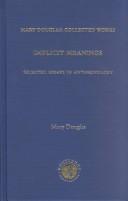
ISBN: 0415291089 0203159829 1280330783 0415205549 0203029909 0415205530 1134626894 9780203159828 9780203029909 9780415205535 9780415205542 9781134626892 9781134626847 1134626843 9781134626885 1134626886 9780415291088 9780415606738 041560673X Year: 2006 Publisher: London Routledge, Taylor & Francis Group
Abstract | Keywords | Export | Availability | Bookmark
 Loading...
Loading...Choose an application
- Reference Manager
- EndNote
- RefWorks (Direct export to RefWorks)
Implicit Meanings was first published to great acclaim in 1975. It includes writings on the key themes which are associated with Mary Douglas' work and which have had a major influence on anthropological thought, such as food, pollution, risk, animals and myth. The papers in this text demonstrate the importance of seeking to understand beliefs and practices that are implicit and a priori within what might seem to be alien cultures.
Ethnology. --- Cultural anthropology --- Ethnography --- Races of man --- Social anthropology --- Anthropology --- Human beings --- Ethnology. Cultural anthropology --- Ethnology
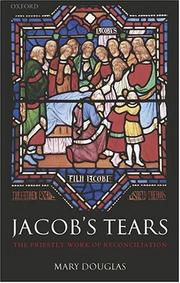
ISBN: 019153272X 1281190721 1435621387 0199265232 9786611190729 0199210640 0191602051 9780191532726 9780199210640 9780199265237 Year: 2006 Publisher: Oxford Oxford University Press
Abstract | Keywords | Export | Availability | Bookmark
 Loading...
Loading...Choose an application
- Reference Manager
- EndNote
- RefWorks (Direct export to RefWorks)
Who is Israel? Who were the priestly authors of the Pentateuch? This anthropological reading of the Bible starts by asking why the Book of Numbers lists the 12 tribes of Israel seven times.
Christianity. --- Bible. --- Authorship. --- Criticism, interpretation, etc. --- Political aspects. --- Israel, Ancient --- Politics and government. --- Christianity --- Antico Testamento --- Hebrew Bible --- Hebrew Scriptures --- Kitve-ḳodesh --- Miḳra --- Old Testament --- Palaia Diathēkē --- Pentateuch, Prophets, and Hagiographa --- Sean-Tiomna --- Stary Testament --- Tanakh --- Tawrāt --- Torah, Neviʼim, Ketuvim --- Torah, Neviʼim u-Khetuvim --- Velho Testamento --- Religions --- Church history --- Chumash --- Five Books of Moses --- Ḥamishah ḥumshe Torah --- Ḥumash --- Kitāb-i Muqqadas --- Mose Ogyŏng (Book of the Old Testament) --- Pentateuch --- Pi︠a︡toknizhīe Moiseevo --- Sefer Ḥamishah ḥumshe Torah --- Tawrāh --- Torà (Pentateuch) --- Torah (Pentateuch) --- Tʻoris xutʻcigneuli --- Ureta --- תורה --- Haftarot --- Bible --- Criticism, interpretation, etc --- Jews --- History --- Judaism
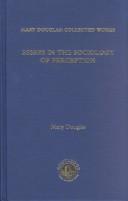
ISBN: 9780415606721 9781136488924 1136488928 0415606721 9780415291040 0415291046 0415283973 9780415283977 1315015803 9781315015804 9781136488993 9781136489068 1136488995 Year: 2003 Volume: 1 Publisher: London : Routledge,
Abstract | Keywords | Export | Availability | Bookmark
 Loading...
Loading...Choose an application
- Reference Manager
- EndNote
- RefWorks (Direct export to RefWorks)
This first volume is a compilation of numerous essays by Douglas on the Lele in the Belgian Congo covering a fifteen year period. There are early indications of Douglas's cultural imagination and written expression that were to make her works accessible and relevant to a western readership of non-anthropologists. The intellectural tools and examples she gained from Africanist ethnography continue to serve her explorations of European and American society.
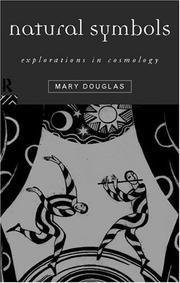
ISBN: 1134773749 1134773757 1280331372 0203036050 9780203036051 9780415138253 0415138256 9780415138260 0415138264 9786610331376 6610331375 9781280331374 9781134773749 9781134773756 9781134773701 1134773706 Year: 1996 Publisher: London ; New York : Routledge,
Abstract | Keywords | Export | Availability | Bookmark
 Loading...
Loading...Choose an application
- Reference Manager
- EndNote
- RefWorks (Direct export to RefWorks)
Every natural symbol - derived from blood, breath or excrement - carries a social meaning and this work focuses on the ways in which any one culture makes its selections from body symbolism. Each person treats their body as an image of society and the author examines the varieties of ritual and symbolic expression and the patterns of social ritual in which they are embodied.Natural Symbols is a book about religion and it concerns our own society at least as much as any other. It has stimulated new insights into religious and political movements and has provoked re-appraisals of cu
Ethnology --- Religion and sociology. --- Human body --- Body, Human (in religion, folk-lore, etc.) --- Religion and society --- Religious sociology --- Society and religion --- Sociology, Religious --- Sociology and religion --- Sociology of religion --- Sociology --- Religious aspects. --- CORPS HUMAIN --- RITUELS --- SYMBOLISME --- ASPECT RELIGIEUX --- MYTHOLOGIE
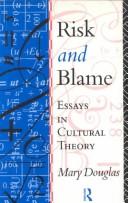
ISBN: 1134811195 1134811209 1282778455 9786612778452 0203430867 9781134811205 9780203430866 0415062802 9780415062800 0415119995 9780415119993 9781282778450 6612778458 9781134811199 9781134811151 1134811152 9781138126619 1138126616 Year: 1992 Publisher: London New York Routledge
Abstract | Keywords | Export | Availability | Bookmark
 Loading...
Loading...Choose an application
- Reference Manager
- EndNote
- RefWorks (Direct export to RefWorks)
Risk and danger are culturally conditioned ideas. They are shaped by pressures of social life and accepted notions of accountability. The risk analyses that are increasingly being utilised by politicians, aid programmes and business ignore the insights to be gained from social anthropology which can be applied to modern industrial society.In this collection of recent essays, Mary Douglas develops a programme for studying risk and blame that follows from ideas originally proposed in Purity and Danger. She suggests how political and cultural bias can be incorporated into the study of risk
Risk --- Risk perception. --- Risk assessment. --- Culture. --- Cultural sociology --- Culture --- Sociology of culture --- Civilization --- Popular culture --- Analysis, Risk --- Assessment, Risk --- Risk analysis --- Risk evaluation --- Evaluation --- Awareness, Risk --- Risk awareness --- Perception --- Sociology of risk --- Sociology of uncertainty --- Uncertainty --- Sociology --- Sociological aspects. --- Social aspects --- Sociological aspects
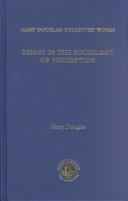
ISBN: 1315888866 9781134557431 1134557434 9781315888866 0415283973 9780415283977 0415291119 9780415291118 9781134557578 1134557574 9781134557509 1134557507 9780415606660 0415606667 Year: 2003 Publisher: London New York
Abstract | Keywords | Export | Availability | Bookmark
 Loading...
Loading...Choose an application
- Reference Manager
- EndNote
- RefWorks (Direct export to RefWorks)
First published in 1982, this is one of Mary Douglas' favourite books. It is based on her meetings with friends in which they attempt to apply the grip/group analysis from Natural Symbols. The essays have been important texts for preparing grid/group exercises ever since. She is still trying to improve the argument of Natural Symbols and is always hoping to find better applications to illustrate the power of the two dimensions used for accurate comparison.
Cognition and culture. --- Perception. --- Ethnopsychology --- Anthropology --- Cross-cultural psychology --- Ethnic groups --- Ethnic psychology --- Folk-psychology --- Indigenous peoples --- National psychology --- Psychological anthropology --- Psychology, Cross-cultural --- Psychology, Ethnic --- Psychology, National --- Psychology, Racial --- Race psychology --- Psychology --- National characteristics --- Supraliminal perception --- Cognition --- Apperception --- Senses and sensation --- Thought and thinking --- Culture and cognition --- Culture --- Ethnophilosophy --- Socialization --- Methodology.
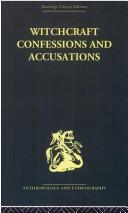
ISBN: 1299480039 113503298X 0203708547 9781135032982 9780203708545 9781135032968 9781135032975 9780415330701 9780415611619 041533070X 1135032971 Year: 2004 Publisher: London : Routledge,
Abstract | Keywords | Export | Availability | Bookmark
 Loading...
Loading...Choose an application
- Reference Manager
- EndNote
- RefWorks (Direct export to RefWorks)
Historians as well as anthropologists have contributed to this volume of studies on aspects of witchcraft in a variety of cultures and periods from Tudor England to twentieth-century Africa and New Guinea. Contributors include: Mary Douglas, Norman Cohn, Peter Brown, Keith Thomas, Alan Macfarlane, Alison Redmayne, R.G. Willis, Edwin Ardener, Robert Brain, Julian Pitt-Rivers, Esther Goody, Peter Rivière, Anthony Forge, Godfrey Lienhardt, I.M. Lewis, Brian Spooner, G.I. Jones, Malcolm Ruel and T.O. Beidelman. First published in 1970.
Witchcraft. --- Black art (Witchcraft) --- Sorcery --- Occultism --- Wicca

ISBN: 0203708784 1299477666 1135033749 9781135033743 9780203708781 0415283973 9780415283977 0415291143 9780415291149 9780415606752 9781135033729 9781135033736 Year: 2013 Publisher: Hoboken : Taylor and Francis,
Abstract | Keywords | Export | Availability | Bookmark
 Loading...
Loading...Choose an application
- Reference Manager
- EndNote
- RefWorks (Direct export to RefWorks)
First published in 1985, Mary Douglas intended Risk and Acceptability as a review of the existing literature on the state of risk theory. Unsatisfied with the current studies of risk, which she found to be flawed by individualistic and psychologistic biases, she instead uses the book to argue risk analysis from an anthropological perspective. Douglas raises questions about rational choice, the provision of public good and the autonomy of the individual.
Sociology & Social History --- Social Sciences --- Social Change
| Listing 1 - 10 of 19 | << page >> |
Sort by
|

 Search
Search Feedback
Feedback About UniCat
About UniCat  Help
Help News
News